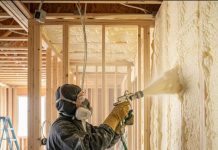intrapleural – внутриплевральный intra-alveolar – внутриальвеолярный collapse – коллапс viscosity – вязкость density – плотность 32. Mechanics of breathing Muscles of respiration: inspiration is always an active process. The following muscles are involved: The diaphragm is the most important muscle of inspiration. It is convex at rest, and flattens during contraction, thus elongating the thoracic cavity. Contraction of the external intercostals lifts the rib cage upward and outward, expanding the thoracic cavity. These muscles are more important for deep inhalations. Accessory muscles of inspiration, including the scalene (elevate the first two ribs) and sternocleidomastoid (elevate the sternum) muscles, are not active during quiet breathing, but become more important in exercise. Expiration is normally a passive process. The lung and chest wall are elastic and naturally return to their resting positions after being actively expanded during inspiration. Expiratory muscles are used during exercise, forced expiration and certain disease states. Abdominal muscles (rectus abdominis, internal and external obliques, and transversus abdominis) increase intra-abdominal pressure, which pushes the diaphragm up, forcing air out of the lungs. The internal intercostal muscles pull the ribs downward and inward, decreasing the thoracic volume. Elastic properties of the lungs: the lungs collapse if force is not applied to expand them. Elastin in the alveolar walls aids the passive deflation of the lungs. Collagen within the pulmonary interstitium resists further expansion at high lung volumes. Compliance is defined as the change in volume per unit change in pressure (AV/AP). In vivo, compliance is measured by esophageal balloon pres sure vs. lung volume at many points during inspiration and expiration. Each measurement is made after the pressure and volume have equilibrated and so this is called static compliance. The compliance is the slope of the pressure-volume curve. Several observations can be made from the pressure-volumecurve. Note that the pressure-volume relationship is different with deflation than with inflation of air (hysteresis). The compliance of the lungs is greater (the lungs are more distensible) in the middle volume and pressure ranges. The equation for oxygen is: QO 2 = CO х 1,34 (ml/g) х [Hg] Ч SaO 2 + 0,003 (ml/ml per mm Hg) х РаО 2 , where QO 2 is oxygen delivery (ml/min), CO is cardiac output (L/min). Hg is hemoglobin concentration (g/L), SaO 2 is the fraction of hemoglobin saturated with oxygen, and PaO 2 is the partial pressure of the oxygen dissolved in plasma and is trivial compare to the amount of oxygen carried by hemoglobin. Examination of this equation reveals that increasing hemoglobin concentration and increasing cardiac output can enhance oxygen delivery. Saturation is normally greater than 92 % and usually is easily maintained through supplemental oxygen and mechanical ventilation. Cardiac output is supported be insuring adequate fluid resuscitation (cardiac preload) and manipulating contractility and after load pharmacologically (usually cat-echolamines). New words
Equation – уравнение Delivery – доставка Cardiac output – сердечный выброс Fraction – фракция Contractility – сократимость 33. Surface tension forces In a liquid, the proximity of adjacent molecules results large, intermolecular, attractive (Van der Waals) forces that serve to stabilize the liquid. The liquid-air surface produces inequality of forces that are strong on the liquid side and weak on the gas side because of the greater distance between molecules in the gas phase. Surface tension causes the surface to maintain as small an area as possible. In alveoli, the result a spherically-curved, liquid lining layer that tends to be pulled inward toward the center of curvature of the alveolus. The spherical surface of the alveolar liquid lining behaves in manner similar to a soap bubble. The inner and outer surface of a bubble exert an inward force that creates a greater pressure inside than outside the bubble. Interconnected alveoli of different sizes could lead to collapse of smaller alveoli (atelectasis) into larger alveoli, because of surface tension, the pressure inside the small alveolus (smaller radius of curvature) is greater than that of the larger alveolus. Without surfactant, gas would therefore move from smaller to larger alveoli, eventually producing or giant alveolus. Pulmonary surfactant: Pulmonary surfactant is a phospholipid (comprised primarily of dipalmitoyl phosphatidylcholine) synthesized by type II alveolar epithelial cells. Surfactant reduces surface tension, thereby preventing the collapse of small alveoli. Surfactant increases the compliance of the lung and reduces the work of breathing. Surfactant keeps the alveoli dry because alveolar collapse tends to draw fluid into the alveolar space. Surfactant can be produced in the fetus as early as gestational week 24, but is synthesized most abundantly by the 35 th week of gestation. Neonatal respiratory distress syndrome can occur with premature infants, and results in areas of atelectasis, filling of alveoli with transudate, reduced lung compliance, and V/Q mismatch leading to hypoxia and CO 2 retention. New words










